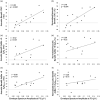Frequency Following Response and Speech Recognition Benefit for Combining a Cochlear Implant and Contralateral Hearing Aid
- PMID: 32003296
- PMCID: PMC7257083
- DOI: 10.1177/2331216520902001
Frequency Following Response and Speech Recognition Benefit for Combining a Cochlear Implant and Contralateral Hearing Aid
Abstract
Multiple studies have shown significant speech recognition benefit when acoustic hearing is combined with a cochlear implant (CI) for a bimodal hearing configuration. However, this benefit varies greatly between individuals. There are few clinical measures correlated with bimodal benefit and those correlations are driven by extreme values prohibiting data-driven, clinical counseling. This study evaluated the relationship between neural representation of fundamental frequency (F0) and temporal fine structure via the frequency following response (FFR) in the nonimplanted ear as well as spectral and temporal resolution of the nonimplanted ear and bimodal benefit for speech recognition in quiet and noise. Participants included 14 unilateral CI users who wore a hearing aid (HA) in the nonimplanted ear. Testing included speech recognition in quiet and in noise with the HA-alone, CI-alone, and in the bimodal condition (i.e., CI + HA), measures of spectral and temporal resolution in the nonimplanted ear, and FFR recording for a 170-ms/da/stimulus in the nonimplanted ear. Even after controlling for four-frequency pure-tone average, there was a significant correlation (r = .83) between FFR F0 amplitude in the nonimplanted ear and bimodal benefit. Other measures of auditory function of the nonimplanted ear were not significantly correlated with bimodal benefit. The FFR holds potential as an objective tool that may allow data-driven counseling regarding expected benefit from the nonimplanted ear. It is possible that this information may eventually be used for clinical decision-making, particularly in difficult-to-test populations such as young children, regarding effectiveness of bimodal hearing versus bilateral CI candidacy.
Keywords: bimodal benefit; bimodal hearing; cochlear implants; electrophysiology; hearing aids.
Figures





Similar articles
-
Clinical Application of Spectral Modulation Detection: Speech Recognition Benefit for Combining a Cochlear Implant and Contralateral Hearing Aid.J Speech Lang Hear Res. 2020 May 22;63(5):1561-1571. doi: 10.1044/2020_JSLHR-19-00304. Epub 2020 May 7. J Speech Lang Hear Res. 2020. PMID: 32379527 Free PMC article.
-
Mandarin Tone and Vowel Recognition in Cochlear Implant Users: Effects of Talker Variability and Bimodal Hearing.Ear Hear. 2016 May-Jun;37(3):271-81. doi: 10.1097/AUD.0000000000000265. Ear Hear. 2016. PMID: 26752089 Free PMC article.
-
Cochlear implantation in adults with asymmetric hearing loss.Ear Hear. 2012 Jul-Aug;33(4):521-33. doi: 10.1097/AUD.0b013e31824b9dfc. Ear Hear. 2012. PMID: 22441359 Free PMC article.
-
Restoring hearing symmetry with two cochlear implants or one cochlear implant and a contralateral hearing aid.J Rehabil Res Dev. 2008;45(5):749-67. doi: 10.1682/jrrd.2007.08.0120. J Rehabil Res Dev. 2008. PMID: 18816424 Review.
-
The benefits of preserving residual hearing following cochlear implantation: a systematic review.Int J Audiol. 2021 Aug;60(8):561-577. doi: 10.1080/14992027.2020.1863484. Epub 2021 Jan 10. Int J Audiol. 2021. PMID: 33426931
Cited by
-
Musical Emotion Perception in Bimodal Patients: Relative Weighting of Musical Mode and Tempo Cues.Front Neurosci. 2020 Feb 26;14:114. doi: 10.3389/fnins.2020.00114. eCollection 2020. Front Neurosci. 2020. PMID: 32174809 Free PMC article.
-
Translational Applications of Machine Learning in Auditory Electrophysiology.Semin Hear. 2022 Oct 26;43(3):240-250. doi: 10.1055/s-0042-1756166. eCollection 2022 Aug. Semin Hear. 2022. PMID: 36313047 Free PMC article. Review.
-
Objective Detection of the Speech Frequency Following Response (sFFR): A Comparison of Two Methods.Audiol Res. 2022 Jan 28;12(1):89-94. doi: 10.3390/audiolres12010010. Audiol Res. 2022. PMID: 35200259 Free PMC article.
-
Guidelines for Best Practice in the Audiological Management of Adults Using Bimodal Hearing Configurations.Otol Neurotol Open. 2022 Jun;2(2):e011. doi: 10.1097/ONO.0000000000000011. Epub 2022 Jun 24. Otol Neurotol Open. 2022. PMID: 36274668 Free PMC article.
-
Unilateral Versus Bilateral Cochlear Implants in Adults: A Cross-Sectional Questionnaire Study Across Multiple Hearing Domains.Audiol Res. 2025 Jan 20;15(1):6. doi: 10.3390/audiolres15010006. Audiol Res. 2025. PMID: 39846559 Free PMC article.
References
-
- Aiken S. J., Picton T. W. (2008). Envelope and spectral frequency-following responses to vowel sounds. Hearing Research, 245, 35–47. doi:10.1016/j.heares.2008.08.004 - PubMed
Publication types
MeSH terms
Grants and funding
LinkOut - more resources
Full Text Sources
Medical

